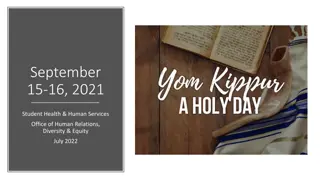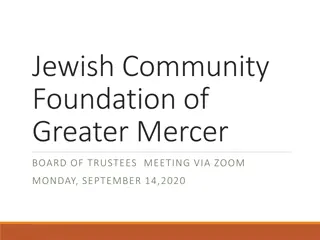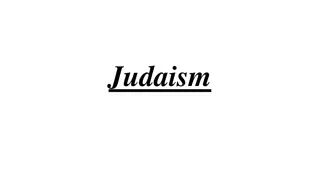Tahara Training for Jewish Burial Preparation
This presentation outlines the traditional Jewish practices involved in preparing deceased individuals for burial, covering physical and spiritual cleansing, dressing, and placement in the casket. It includes a glossary of terms and emphasizes the importance of maintaining reference manuals for consistency and community customs.
Download Presentation

Please find below an Image/Link to download the presentation.
The content on the website is provided AS IS for your information and personal use only. It may not be sold, licensed, or shared on other websites without obtaining consent from the author. Download presentation by click this link. If you encounter any issues during the download, it is possible that the publisher has removed the file from their server.
E N D
Presentation Transcript
Tahara Training Prepared by Rick Light For the North American Chevra Kadisha and Jewish Cemetery Conferences Organized by Kavod v Nichum First presented in June 2006 Revised Jan 2013
General Outline Preparation procedures. Washing the meit(ah) Physical cleansing. Tahara Spiritual cleansing. Dressing the meit(ah). Placing the meit(ah) into the aron. Cleaning up. Debriefing. 2
Disclaimer The procedures used by Chevra Kadisha groups to prepare Jewish bodies for burial are largely minhag local customs passed down from generation to generation. Some organizations may use different procedures from those presented here. What is presented here is an amalgam of the most common procedures among a variety of chevra groups. 3
Reference Manuals Each Chevra Kadisha should maintain or prepare a manual of its procedures. This: Ensures consistency of quality. Preserves community customs. Makes training more consistent. Facilitates communication. A partial list of reference manuals is given at the end of this presentation. 4
Glossary Afar earth from Israel placed into the casket and on the meit(ah). Aron the casket. Jewish custom suggests the casket be made of plain wood, without metal, and be minimally adorned. Chevra Kadisha lit. Holy Fellowship, the Jewish Burial Society responsible for properly preparing Jewish bodies for burial. It is customary for this group to work anonymously within the community performing Tahara rituals when needed. Dom blood. K vod hameit honoring (showing respect for) the dead. Meit a deceased man. Meitah a deceased woman. Sovev sheet placed into the casket, wrapped around the meit(ah). 5
Glossary Continued Tachrichim burial shrouds, specifically the clothes (usually plain linen or muslin) intended to represent the attire of the High Priest, as follows: Mitsnefet a full-head-covering (including face) for a man, bonnet for a woman. Michnasayim trousers with a tie at the waist and often the legs are sewn shut at the feet. K tonet long-sleeve shirt with no collar, with tie at neck. Kittel long-sleeve robe or jacket with collar, with tie at neck. Avnet or Gartle simple linen strap used as a belt. Apron simple apron of linen Tahara the ritual cleansing of the deceased to provide spiritual cleansing before burial. Sometimes used to mean the entire process of the physical and spiritual washing of the meit(ah), the dressing in tachrichim, and the placing of it into the casket. 6
Preparation Pre-briefing: assign tasks, clarify assignments, review rules, be sure team is emotionally prepared: Who is the leader? single person in charge. Who is/are the reader(s) designated person(s) or everyone. Who will organize the shrouds (tachrichim)? Who will organize the casket (aron)? Who will organize the supplies, buckets, equipment? Divide these tasks among the Tahara team as appropriate. Is everyone emotionally OK to do this? Everyone participating should know what is expected. Leader directs all activities, makes all decisions. Leader should have advisor available if needed. 7
Preparation Continued Some thoughts on reader responsibilities: All readings should be read carefully and clearly aloud. Some groups have the entire team read together in unison. Some groups memorize the readings ahead of time. Can be read in Hebrew, or English, or both (simultaneously, Hebrew chanted softly, English read aloud). Should be read such that the Tahara team understands what is being read. Should be read with kavanah (sincerity and intent to honor the dead). 8
Preparation Continued Basic rules of k vod hameit (honoring the dead): Assume an attitude of respect for the dignity of the dead. Always refer to the meit(ah) by his/her name. No unnecessary conversation. Do not stand at head of meit(ah) except when necessary. Pass nothing over the body of the meit(ah). Follow directions of the leader, disagreements should be resolved later (after completion of the Tahara). Details of Tahara events are confidential to the team. 9
Preparation Continued Entire team states intentions and asks for guidance before entering Tahara room: Source of kindness and compassion, grant us the courage and the strength to properly perform this work, guide our hands and hearts help us to see Your holiness in the face of the deceased and in the faces of each other 10
Preparation Continued Enter Tahara room in silence, set things up: Some groups light a candle. Don personal protective clothing, ritually wash hands, double glove. Fill 2 containers for physical washing (warm water). Organize shrouds (tachrichim). [details later in this presentation] Organize casket (aron). [details later in this presentation] Organize supplies so tools are at hand. Remove all clothing, hospital gowns, tags, medical apparatus, etc. The meit(ah) should be naked under clean sheet. Save jewelry, hearing aids in bag for funeral director. Do not remove false teeth or contact lenses. Put name tags in casket. 11
A Note About the Candle Some chevrot light a candle when they enter the Tahara room: It stays lit during the entire process. It then is placed at the head of the aron upon completion of the procedures. This is done for several reasons: Reminds everyone of the holiness of life and death. Represents the life of the deceased. In remote or unusual circumstances, it can act as shomer until burial. Reminds the funeral home personnel in non-Jewish funeral homes that this is a Jewish burial. 12
Washing the Meit(ah) Some thoughts about respect: The meit(ah) is covered with sheet at all times except during rinsing and the Tahara itself. Uncover only small portions of body at any one time. Speak softly and only when necessary. Clean the body gently. Most important thing: Have intentions of kindness, dignity, and respect toward the meit(ah). 13
Washing the Meit(ah) Continued Say Chamol. Say Vaya an Vayomer while clothing is cut off. Place clean dry sheet over naked body. Cleanse entire body: head, right side, left side, front, back. Use warm water, be gentle, be thorough. Collect any blood, fingernail clippings, or hair in bag that goes into aron. 14
Washing the Meit(ah) Continued As body is washed, recite: Hinakh Yaffah(for a woman), or Rosho Ketem Paz(for a man, and sometimes for a woman). Some have custom to rinse entire body after washing: Turn body, pour entire length of right side. Turn body, pour entire length of left side. Pour entire length of front. Dry body and table. Cover body with clean dry sheet. Discard gloves; wash hands again, reglove. 15
The Ritual of Tahara Fill containers with 24 quarts of cold water (eg., 3 buckets of 8 quarts each). Dip boards in bucket water, place under meit(ah). Recite Amar Rabbi Akiva. Some groups have canopy minhag clean sheet becomes chupah over the meit(ah) during pouring. Those holding sheet face away from the meit(ah). Need at least 4 (preferably 5 or more) team members present. Uncover meit(ah), then pour water in continuous flow of 24 quarts: As one bucket completes its flow the next is started. Pour right side first, then left, then center. Start at head, pour entire length of body. There are minhag variations to this. 16
Tahara Continued While pouring occurs, all team members recite: For a Woman: she is pure Tehora hee, tehora hee, tehora hee. For a Man: he is pure Tahor hu, tahor hu, tahor hu. If there is a break in the flow, refill and repeat pouring. Lower canopy sheet onto body, or cover body with clean sheet immediately after pouring is completed. Dry the meit(ah) and table thoroughly, cover with clean dry sheet. Use different towels for body and table. Remove boards, set aside for cleaning later. 17
Dressing the Meit(ah) Dressing basics: In death all are equal to the Kohen Gadol, the High Priest. Therefore, we dress everyone in tachrichim identically. Shrouds (tachrichim) should be laid out ahead of time in the order needed to facilitate this process. Carefully support head at all times during dressing. Team members on opposite sides of table work together in dressing and knot tying . Recite Sos Assis. 18
Dressing the Meit(ah) Continued Order of dressing: Keep face covered with small cloth until head covering later. 1. K tonet (collarless shirt) Recite you shall wear a holy tunic Tie knot at neck. 2. Mikhnasayim (pants) Recite and linen breeches shall be on your flesh Tie knots at waist and ankles (man) or below knees (woman). 3. Kittle (jacket with collar) Tie knot at neck. 19
Dressing the Meit(ah) Continued Order of dressing continued: 4. Avnet / gartel (belt) Recite and a linen sash shall you tie Tie knot at waist. Tuck cut-off tzitzit into the belt (if tallit is present) 5. Cover the head: For a woman: place on the veil, then mitznefet (bonnet) Recite and a linen headdress shall you don For a man: place on a kipah, then mitznefet (hood) Recite and a linen headdress shall you don 20
Dressing the Meit(ah) Continued Knots are important part of dressing the meit(ah). Two people work together to twist, then one ties the knot, as appropriate. Count aloud alef, bet, gimel, dalet delineating 4 twists. The following diagrams show how this is done. 21
Moving into the Aron Casket (aron) should be prepared ahead of time, but if necessary do this now: Remove all fancy innards, some leave a little straw for pillow. Drill holes in bottom (if possible, do outside of Tahara room); check with funeral home and Rabbi before drilling. Sovev (sheet) should be diagonally draped across aron. Tallit should be draped in place ready to wrap shoulders (with one tzitzit removed). Afar (Israeli earth) should be sprinkled inside. Recite Vehu Rahum. Place pillow sack with straw and afar inside into aron. 30
Moving into the Aron Continued Move body respectfully into aron, laying meit(ah) gently onto sovev. If room allows, place aron at foot of table, lift from both sides of table, walk to aron and lower meit(ah) into aron. Alternatively, place aron next to table, parallel to it, lift from side of table and from across aron, gently move body into aron. Some funeral homes have hydraulic lifts that can easily lift the body. Always support the head during the move. Recite Velo Yavo u. Sprinkle afar on eyes, mouth, genitals, heart. Recite Vekhiper Admato Ano. 31
Moving into the Aron Continued Place pottery shards (sherbloch) over eyes and mouth. Wrap tallit over shoulders. Wrap sovev around meit(ah). feet, right side, left side, head Recite Hinei Mitato. Entire team asks meit(ah) for forgiveness for any disrespect during this procedure. Place lid on aron; some place the lit candle on lid. Recite Uvinsoa Hamishkan. Wheel aron (feet first) into area where shmira can continue. 32
Cleaning Up Team restores order to Tahara room. Wash and dry boards placed under meit(ah). Clean and put away supplies. Place dirty laundry into appropriate container. Dispose of biohazard materials appropriately. Remove gloves, smocks. Wash hands ritually, then with soap/hot water. 33
Debriefing Participation in Tahara is among the most powerful of human experiences. Intense feelings and reactions are common. Very important to support each other and set aside time to address and honor these. Immediately after Tahara, team should discuss feelings. Leader should follow up if team members have issues. Confidentiality and sacred space awareness is essential, as is anonymity of those participating. 34
Handling Difficult Situations Some Taharot require special effort: Infectious diseases, must assume the worst. If funeral home gives specific instructions, follow them. Violent death sometimes ritual Tahara cannot be performed, or the meit(ah) cannot be dressed as usual. Wash as best you can, pour as best you can, lay tachrichim on the body if you cannot dress it. Body wastes and excretions. Fluid flows that are difficult to stop. Removal/handling of various medical items attached to the body. Leader must decide on the spot how to handle these situations. 35
Reference Manuals Epstein, Mosha. Tahara Manual of Practices Including Halacha Decisions of Hagaon Harav Moshe Feinstein, zt l. Bridgeport, CT: 3rd Edition, 2005. (Available From Kavod v'Nichum) Kelman, Stuart. Chesed Shel Emet, The Truest Act of Kindness. EKS Publishing, Albany, CA: 2000. Light, Rick. Guidelines for Performing Tahara. Chevra Kadisha of Northern New Mexico, Santa Fe, NM: 2nd Edition, 2005. Sandler-Philips, Regina. PSJC Hevra Kadisha Tahara Manual. Park Slope Jewish Center, Brooklyn, NY: 2nd Edition, 2009. 36
Reference Manuals Continued Schlingenbaum, Yechezkel. Tahara Guide. New Haven Chevra Kadisha, New Haven, CT: 1993. Also of interest: Berman, Rochel U. Dignity Beyond Death, The Jewish Preparation for Burial. Urim Publications, Jerusalem: 2005. 37
Questions? 38























